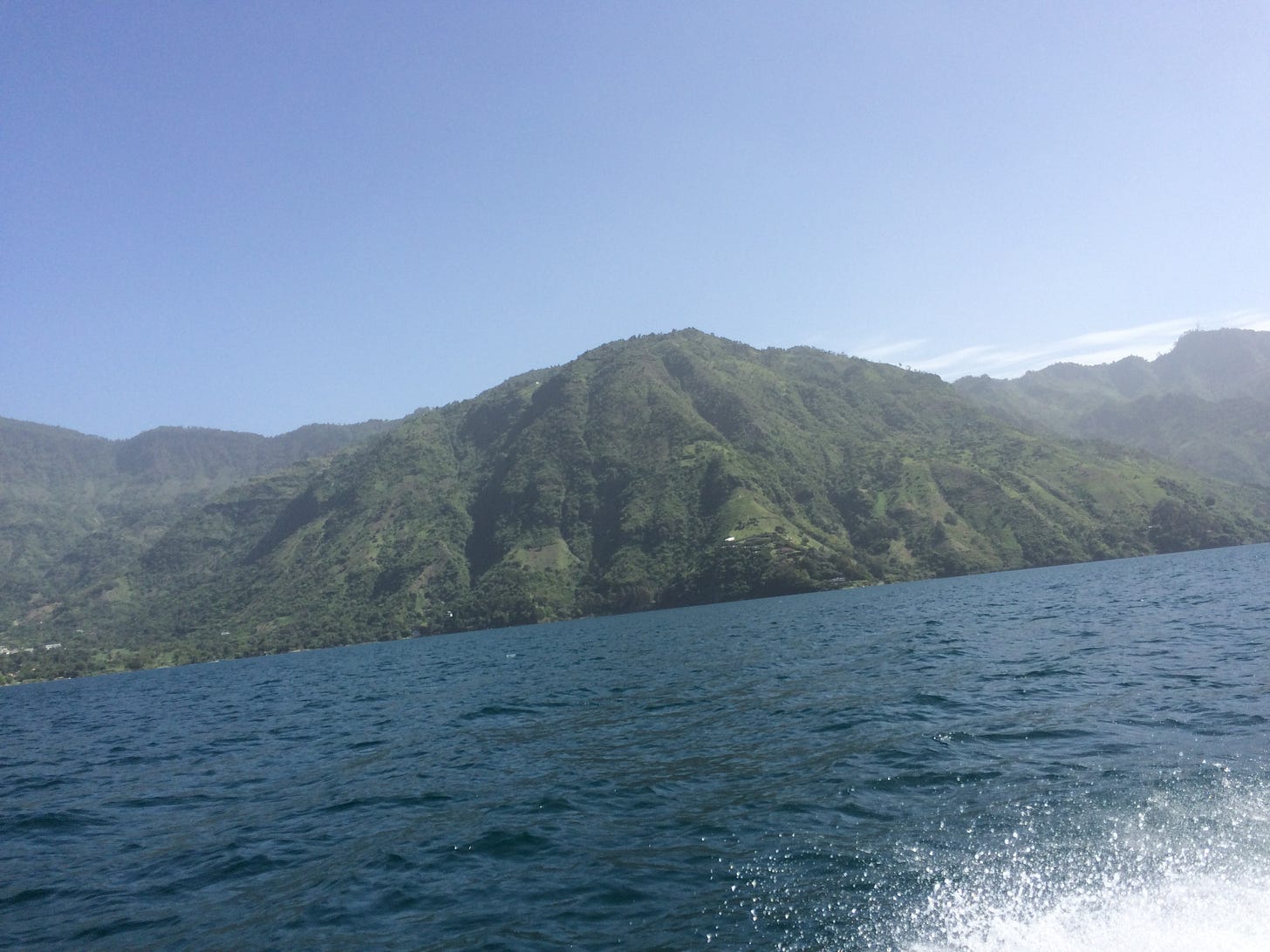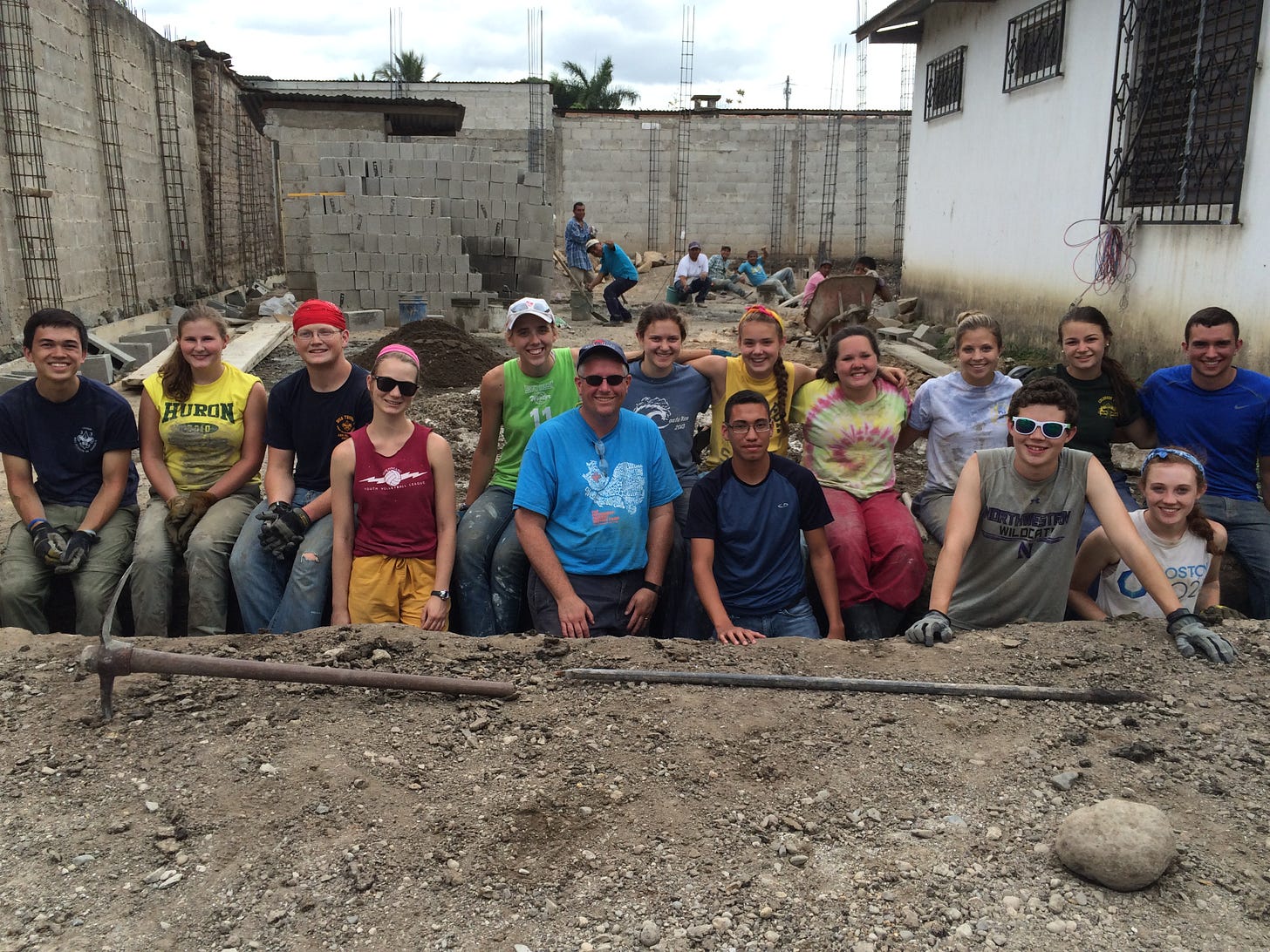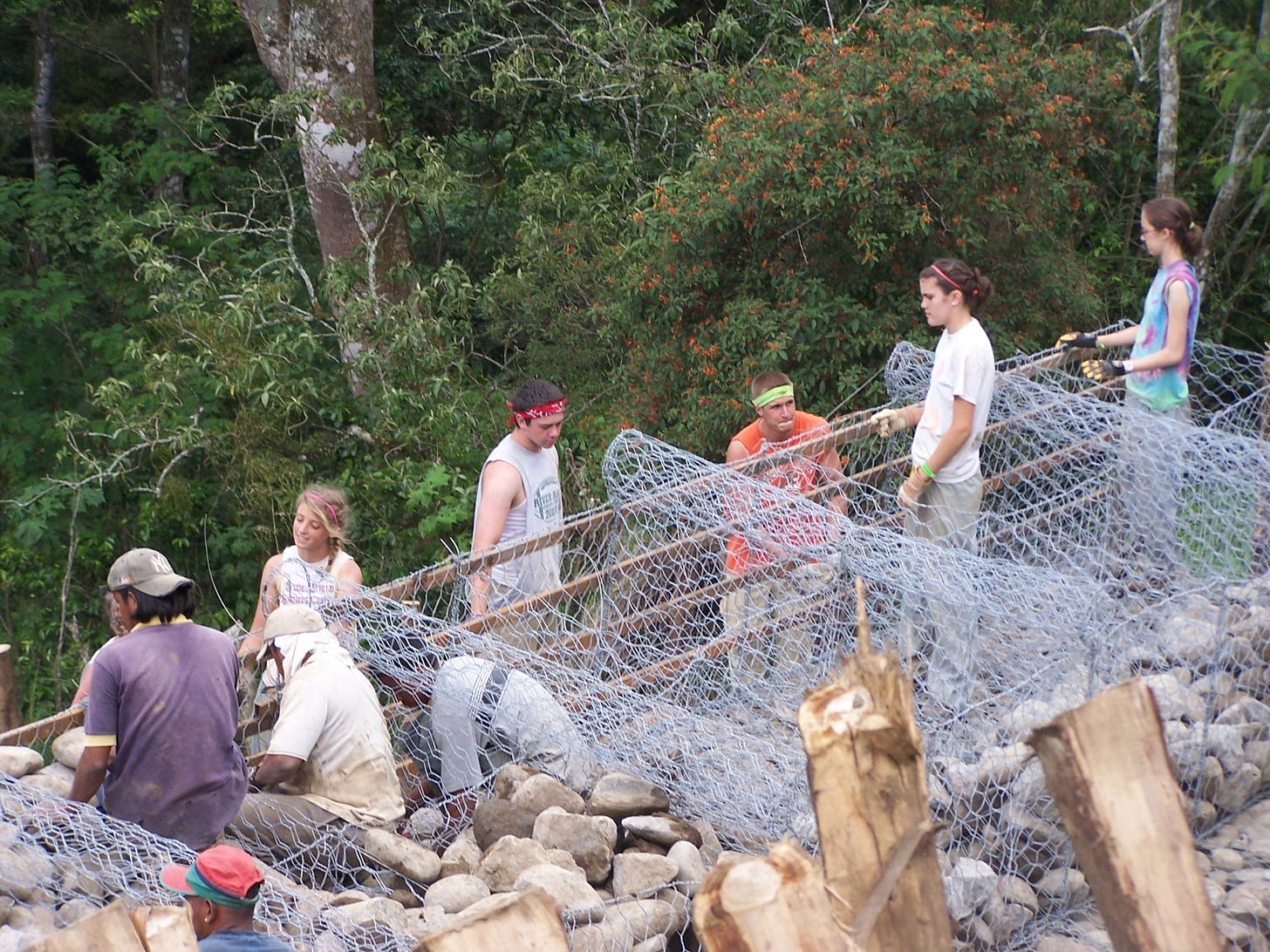Lake Atitlan, Guatemala, June 2015.
Most of my Facebook cover photos are landscapes from different mission trips. Today’s is a birch tree forest from Fraser, Colorado. Next week it might be Lake Atitlan, Guatemala, or the desert of Las Cruces, New Mexico.
Leading a group of adults or high schoolers on a mission trip to somewhere new and different helps with recruiting as it sparks vital interest.
Since leading my first intergenerational mission trip to the Collinwood neighborhood of Cleveland, Ohio, I have led 35+ mission trips to 9 states and 4 countries with anywhere from 9-65 people.
Picking a Place for a Mission Trip
The key to choosing a place for a mission trip is to be clear on what the purpose of the trip is.
An adult mission trip’s purpose may be to help integrate friends into the community of your church by helping others. Or you may want to build community by serving others. Or you may be responding to a recent crisis like flooding or a tornado.
Purpose of High School Mission Trips
The purpose for a youth mission trip is usefully threefold for me:
Build unity across churches and friend groups.
Experience the presence of Jesus by living in an authentic Christian community.
Discover a new place to serve alongside people in their community.
Aside: Why Not to Do a Middle School Mission Trip
Middle school (6th-8th/9th grade) is where we lose our youth from the church. Do 2-5 half-day mission projects with this age group. Anything longer will lose the attention of some of the group. If we press them to be as dedicated as the more mature youth who can work longer, we risk unintentionally teaching them that they don’t belong in the youth group.
Use your summer middle school trip for summer camp or doing something fun so they can bring friends and you can build a group of youth who want to be together and know how to travel together.
Digging footings for a new church kitchen in Jalapa, Guatemala, June 2014. This team includes youth from churches in Ann Arbor and Boise, Idaho plus a 19-year-old translator who grew up in New Jersey but has returned to Jalapa when his undocumented parents needed to return to care for his grandparents.
Criteria for a Good Mission Trip Location
When I am looking to find some locations for a future trip, I want to pick something three months out for a weekend trip and 8-9 months out for a week trip.
The criteria I use include:
A good local host (see more on this below).
A place with enough bathrooms and separate sleeping rooms for non-binary/ally, men, and women.
Meals either on-site or within a 10-minute van ride.
Quality work that needs to be done.
A work host or site supervisor available by cell at all times
Safe outdoor space for free time
Somewhere new to the youth
Let’s dig into these.
Good Local Host
The best local host is one that lives in the community we are visiting and loves their community. I often work with the good people at Mission Serve who have church partners in most of the locations they offer. When we are on the mission trip site, they have a local person who has set up the sleeping location, the meal service, and the work sites.
On our joint mission trip1 to Las Cruces, New Mexico Mission Serve worked with a local carpenter and his wife who arranged our sleeping at a local public elementary school and meals cooked on-site. Our work was provided by the City of Las Cruces which went the extra mile to welcome us by providing showers at the community center. Our work was sanding and staining the handicapped ramps of their senior citizens. All materials were provided by the city.
For a trip to Jalapa, Guatemala Mission Serve paired us with a local pastor who did a phenomenal job arranging our sleeping rooms at a local hotel with meals provided by a forming church. Our work project was building footings for the new church kitchen as well as running a Vacation Bible School for 140 children for the unchurched outside the town. Everything was done in Spanish as few people spoke English in Jalapa.
Mission Trip Sleeping Arrangments
Elementary or middle schools or church education wings, work great for sleeping quarters for mission trips. Sometimes hosts have bunks to use which can be comfortable (or not). Most of the time we are sleeping on air mattresses which we have the team bring.
It is great to have rooms for the Junior/Senior, Freshman/Sophomore youth divided by gender.2 Conversations the older youth have are often quite different from the younger youth so separate sleeping areas can allow everyone to be more themselves.
Adult Sleeping Space
On some trips, we’ve offered adult sleeping space so that only two adults are in with the youth sleeping space. This can give you better-rested adults.
Always let the adults choose what space they want in a sleeping space before the youth choose. Some adults want easy access to the door (bathroom) or want to be along a wall for more privacy.
Mission Trip Meals
The big question is whether or not cooking your own meals helps your trip’s dynamics?
Some churches have two people who love to cook and can go on a trip and take charge of the kitchen and meals. If you go this route, make sure you bring two adults as one adult focused on the cooking may not also be gifted in organizing the youth to help.
I prefer to pay someone to cook for the mission team. This way they know the kitchen, the local shopping, and they do not have to focus on the youth. Sometimes, I can find a local diner that will prepare our breakfast and dinner for us for a set price. This can be a delicious and cost-effective solution.
Quality Mission Work
While on a mission trip to Indiana, a youth from a church in Boise told me about his trip the year before where he found himself painting a wall that didn’t need to be painted. Some organizations want summer mission teams so they can use the money paid to support their operating costs for the year. Better groups can do both by finding work that needs to be done for our mission teams.
Ann Arbor High schoolers work alongside Nicaraguan day laborers building a retaining wall for a low-income apartment complex in San Jose, Costa Rica, June 2009.
Things Youth Can Do With Guidance
If the local host can ensure a local carpenter or well-gifted DIY-er is available to guide the difficult jobs, your youth can do a lot of meaningful work. Here are some projects we have done on mission trips with high schoolers:
Hang gutters (Norfolk, Pittsburgh, Charlotte)
Shingle a roof (Atlanta, Norfolk)
Landscaping and Trash Removal (Atlanta, Cleveland, Pittsburgh)
Drywall (have each senior pack a 25 ft. tape measure)
Replace windows and doors (pack a level - they never have enough)
Build a rock retaining wall (see above)
Paint, Paint, Paint (Everywhere)
Dig and pour footings (Belize, Guatemala, Navajo Mountain)
Build concrete block walls (Jamaica, Costa Rica)
Lay new flooring (Pittsburgh, Charlotte, Houston)
Build handicapped ramps (Las Cruces, Costa Rica)
The Work Guidance
The Pittsburgh Project uses a great model or having retired and working carpenters and excellent DIY-ers assigned to each work site. We meet the night before and talk over any questions. They rotate on the workdays through their 3-5 worksites helping on the hard stuff, answering questions, and encouraging the youth.
On one cold November work weekend, I was working with two seniors trying to figure out how to support a large ladder on a slope (all of Pittsburgh) to caulk a window. The DIY-er arrived to show us how to support the ladder. My senior said it still looked too sketch would this guy mind doing it? They held the ladder and this math teacher scurried up to the second-story window and caulked the window well.
High schoolers relax on the swings with a child at the Caribbean Christian School for the Deaf, Montego Bay, Jamaica, in 2011.
Safe Outdoor Space for Free Time
One of the ways to build an effective youth mission trip is to schedule the trip with 5-6 hours of work (8-3ish), half-hour work site clean up and travel time for 2 hours of free time before dinner. The youth need this two-hour block of free time for basketball, checking their phones (in sleep rooms), euchre3, and just hanging out.
We always set a boundary which may be the school or church property. One of our four trip rules4 is “When you are inside, you are inside.” We use this to shrink the boundaries as the day ends till the “inside” is sleeping rooms and the walk to the bathrooms.
Go Somewhere New
The church should do local mission work. A week-long mission trip should be far enough away that it feels new and exciting. We may be able to fill a trip of adults for the week project in our local city.
If we want the parents of our youth to have their children miss their sports teams, computer camps, summer jobs, and theater events, a distant location is a better ask. When we offer something new and exciting we can generate interest.5 Find a location that excites you to visit and serve. Pray about this. Let God lead you to the place that energizes you.
To Wrap Up
The key to finding a great location for your next mission trip is working with a host with local connections that they work with all the time.
For some trips, we do a pre-visit in February or March so that we can get pictures to share with families and to make sure the work, sleeping sites, and meals are organized. For other trips, I make phone calls and talk to the local host to find out what they need from us as well as what we need from them.
On one such phone call, I learned that what the school needed more than anything was plumbing supplies to fix the toilets, showerheads, and leaking faucets (salt air corrodes everything metal). Home Depot donated $300 worth of plastic/metal plumbing fixtures when our youth asked the local manager.6
If you have any questions or want to talk about mission trips, put your questions in the comments or click the link to send me an email.
Joint mission trip with a church in Ann Arbor where I was on staff and two churches from Boise, Idaho where a friend pastored.
For non-binary youth have a good discussion with the youth and parent about what would make the youth most comfortable. Also, it is helpful if we talk to some ally youth and parents who can share sleeping space with an ally adult leader so the group experience continues without isolation.
Beloved French four-person card game and a staple of Michigan college, cottage, and snowy winter night.
As the trip leader, I begin with the church’s rules which are already established (like no firearms, tobacco/vaping, drugs) and give the upperclassmen two more rules. Then they set the rest of the trip rules. My two rules are a. Always go with a buddy. b. When you are inside, you are inside. They often add rules like c. Be chill (relax and go with the flow trying new things). d. Stay out of other people’s stuff. e. Always be kind to people we meet. f. Get out of your comfort zone and try new things/meet new people.
Some church leaders swear by the same location every year. For adults, I can see this. But for youth groups, I’m not convinced that this model works for growing your youth team beyond the regulars. New locations build interest.
A Delta Airlines pilot from Boise, worked with three rotating youth to fix the plumbing. He loved making such an important difference.






